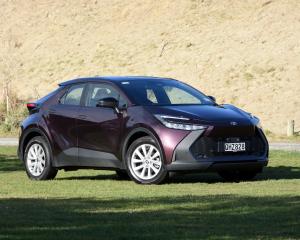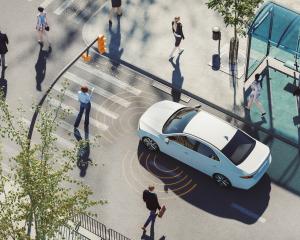
More broadly, each upsizes over its respective predecessor, introduces common new technology — large touchscreens and the DSG automatic gearbox selector moving up to the steering column, so you simply twist forward for go, and backwards for reverse — and are better finished and furnished. Yet, in driving and ambience, they are clearly evolutionary. Skoda has patently decided not to throw the aesthetic baby out with the design bathwater.
That, in a nutshell, spells out the new generations of the Kodiaq sports utility and Superb, the latter now available solely as a station wagon.
Visually these, the largest cars Skoda makes, also present as exercises in design refinement, being immediately recognisable as successors to outgoing equivalents.
From the outside each model features a slightly larger octagonal-shaped grille, thinner headlights and slightly softer, simpler overall look.
Within, the driver of either looks at essentially the same dashboard, and touches many of the same controls; located in the same spots, doing the same things.
The big change is an upgrade to tablet-like touchscreens — 10-inch types in yet-to-show base Kodiaqs, 13 inches in the Kodiaq diesel that’s here now, and standard to the Superb.
Any decision to deliver fewer buttons can cause shudders among the screen-phobic, but this is Skoda, the "sensible" one of the VW Group, with the menu structure and on-screen layout that is simpler and easier to understand than it used to be.

Moving the gear selector to a new location behind the steering wheel allows more generous storage in the centre console. Adjustable cupholders, space for twin wireless phone chargers and useful shelves are common features now.
Two glove boxes, one upper and one lower, further benefit the Kodiaq.
The instrument display screen is also fully digital and, again is pleasantly useful. You can adjust the information displayed, the general layout and "theme" with buttons on the steering wheel.
This operational commonality reinforces that, regardless of the fact they are physically different cars aiming at different customer bases, there is a lot of shared DNA.
New bodies on top of the same core mechanical package as the predecessors is the big clue: the latest Kodiak and Superb both use the familiar Volkswagen Group MQB platform that’s been around since 2015.
Having presented in the past, at various states, as a petrol and diesel, then purely diesel, then purely petrol, some with front-drive, some with all-wheel-drive, the Superb has now settled into being an all-paw car, in two levels of trim, with a common 195kW/400Nm 2.0-litre petrol engine and a seven-speed direct shift gearbox. It’s priced at $74,990 for the Superb wagon TSi 4x4, while the alternate Sportline holds a $9000 premium. It arrives in April.
The Kodiaq presents initially with a 142kW/400Nm 2.0-litre turbo-diesel in all-wheel drive, and carrying the same $74,990 tag as the Superb. Priced from $54,990, a 110kW/250Nm 1.4-litre front-drive in "110" base and "110 plus" formats will arrive from March, and a performance 2.0-litre petrol all-wheel drive RS is due to land in June-July — this producing 195kW/400Nm, so 15kW and 30Nm more than the outgoing generation. All fit seven-speed DSG transmissions.

Says Skoda New Zealand general manager Alex Brown: "I think mild hybrid’s probably where consumers are heading ... the PHEV doesn’t seem to be fitting the narrative in this country at the moment."
The diesel is one past owners know; it was with the previous Kodiaq from initial release in 2017 to the time of the last big facelift in 2022, thereafter being dropped as a means to achieve better fleet compliance to the then Clean Car emissions regulations. The relaxation of those emissions targets, plus customer feedback factor, fed into a change of corporate policy.
"Customers made it very clear that they missed this engine and would like to have it back," Brown said, noting that while Kodiaq had always been Skoda’s biggest seller, losing the diesel factored into the car dropping from 38% of family volume share in the year of facelift to 23% in 2024.
The diesel’s power is down 5kW and CO2 output now is 2g/km dirtier, but that’s easily offset for Skoda as a whole by clean air credits earned by the fully electric Enyaq and a smaller SUV sibling, Elroq, which is landing in June (when Enyaq is updated).
My first driving involvement with the new models was cursory, but straight away the diesel seemed the perfect choice for the Kodiaq. It would be great in the Superb, too, but there’s no plan for that, more’s the pity. It’s so relaxed in operation — only when really gunning it do you discover the rev counter needle isn’t permanently constrained to the 1000-2000rpm zone — and extremely refined and smooth.
The specification detail common to both cars is solid; hill-hold, electronic child safety locks, seven airbags, all-round vehicle monitoring with driver assistance, adaptive cruise control, keyless entry and ignition, dual-wireless phone charging pads, three-zone climate control, front and rear parking sensors, reversing camera, electric tailgates, ambient cabin lighting, heated and cooled front seats, electric driver seat adjustment and alloy wheels. Both hold the maximum 5-star European NCAP safety rating.
Superb’s wheelbase has not changed, but external dimensions have altered; it’s 40mm longer and 5mm taller, yet also 15mm narrower than previously. A fraction more headroom is on offer in both the front and back, and the boot gains an additional 30 litres with all five seats in play, resulting in a whopping 690-litre figure. As before, this is a simply vast car on the inside, with rear-seat passengers benefiting from impressive legroom.

As a five-seater, it lends a 845-litre boot up to the luggage cover. Stow all but the font seats and this becomes a van-like 2000-litres. The boot comes with a selection of hooks, a 12-volt power socket and little dividing panels that affix to the floor with velcro. There’s useful under-floor storage and a slot into which the retracting luggage blind can go when all the seats are folded down.
"Simply Clever" extras no longer include a torch, but umbrellas and an ice-scraper remain, plus there’s a tablet holder in the rear armrest, which also forms the cover for cupholders, and a blackboard duster-like screen cleaner that stows in the armrest holder.
Overall? These are the cars that Skoda does best. In 2025 they seem to be done just a bit better.
SKODA KODIAQ SELECTION TDI
SPECIFICATION
Price: $74,990.
Powertrain: 2.0-litre four-cylinder turbo-diesel engine. Maximum power 142kW, maximum torque 400Nm.

Safety rating: Five star European NCAP.
Wheels and tyres: Alloy wheels 235/50 R19 tyres.
Fuel and economy: Diesel, 5.2 L/100km, tank capacity 58 litres.
Emissions: 170 grams per kilometre on combined cycle (WLTP-3).
Dimensions: Length, 4758mm; width, 1864mm; height, 1659mm.
SKODA SUPERB
SPECIFICATION

Powertrain: 1984cc four-cylinder turbo petrol engine. Maximum power 195kW, maximum torque 400Nm.
Transmission: Seven-speed direct shift gearbox, all-wheel-drive.
Safety rating: Five star European NCAP.
Wheels and tyres: Alloy wheels 235/40 R19 tyres.
Fuel and economy: Petrol, 8.2L /100km, tank capacity 66 litres.
Emissions: 186 grams per kilometre on combined cycle (WLTP-3).
Dimensions: Length, 4902mm; width, 1849mm; height, 1482mm.
By Richard Bosselman












